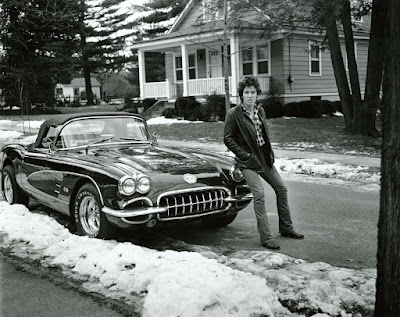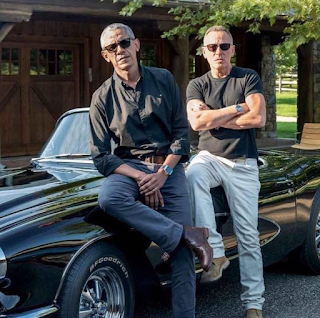This photo of Bruce Springsteen and his 1960 Corvette, now known as "Corvette Winter", was shot in February, 1978 as part of the shoot for the artwork for Springsteen's 1978 album, "Darkness on the Edge of Town". It was shot by photographer Frank Stefanko in front of Stefanko's home in Haddenfield, New Jersey.
Springsteen brought several sets of clothing to the session and Stefanko took a number of different photographs of the rising rock star over a several-day shoot. Springsteen also came to the shoot each day in a different vehicle. The day before "Corvette Winter" was shot, he showed up in a Chevrolet C/10 pickup.
After a number of different poses, wardrobe changes and adjustments to lighting, Stefanko took a photo Springsteen believed was emulative of the characters and songs on the album he had just finished recording. Dark, gritty songs that were unlike anything on the romantic "Born to Run" album that catapulted Springsteen to superstardom.
After the success of "Born to Run", Springsteen became embroiled in a long legal battle with his manager, Mike Appel. Springsteen claimed he received minimal publishing or royalties from the release of "Born to Run" and sued Appel. Appel, in turn, counter sued Springsteen going so far to block Springsteen from entering a recording studio. Thus, the near-three year "hiatus" between the releases of "Run" and "Darkness".
The entire legal affair, which, purportedly, allegedly or conveniently, resulted not only in a wiser if not "darker" Springsteen, but in a follow up album to "Born to Run" that was somber if not downright depressing. Springsteen and his band recorded fifty-two songs for the album, many of which reflecting Springsteen's 1960's pop, rock and soul influences and sensibilities, but Springsteen insisted anything upbeat not be included on "Darkness".
Springsteen has noted publicly that the only thing he got from the release of "Born to Run" was a grand piano and his 1960 Chevrolet Corvette. Springsteen, apparently, still has this car.
With regards to the car, story goes that flush with cash after "Born to Run" went to number three on the Billboard Album 200 chart, Springsteen bought the car for $6,000 from a young attendant working the counter at an ice cream parlor in the Freehold, New Jersey area. Who knew that shucking ice cream in the mid-Seventies paid so well. Frank Stefanko said that Springsteen loved the car and was "everything to him". Clearly, Springsteen loved it enough that he spent almost as much on a then fifteen-year-old Corvette as a new, 1975 Corvette would have cost him.
The above car, part of a display at the Rock and Roll Hall of Fame in Cleveland, Ohio in 2009-2010, is not the "Corvette Winter" Corvette. I thought about turning this entire blog into a rail about how the Rock Hall Corvette is not the "Corvette Winter" car but thought better of it. What would be the point? Especially considering that Springsteen exhibit was now more than a dozen years ago.
Sadly, there isn't much information available about the car itself. Springsteen, allegedly, is a "car guy", although the definition of what a "car guy (or person)" is varies; not all of "us" are Jay Leno. Springsteen also has a 1963, split-rear-window, Corvette Sting Ray, a 1969 Ford XL convertible, a 1970 Ford F-100 pickup, a 1982 Chevrolet Camaro Z28, and I'm sure he has others. A fan of "driver's" and not museum pieces, bless his Hungry Heart, clearly none of his drivers are as famous as the Corvette Winter Corvette. He chose it to be be featured in the March 2022 episode of the podcast that he does with President Obama. Obama even drove it.
In publicity stills for the podcast, we see the 1964-vintage Crager SS rims on the car and not the 1960-correct wheel covers the "Rock Hall" car has. It also has raised-white-letter tires and not (yuck) whitewalls and we see the car lacks the Rock Hall car's optional two-tone paint scheme; I much prefer the look of no two-tone first-gen or "C1" Corvettes. The above car is the real deal. The Rock Hall car, again, is not.
With so little information about the car itself, I'm left with plastering my face into the handful of pictures I can find of it attempting to find something, anything about the actual car. And, voila. Look - we see the radio to the right of Springsteen's knee is a Pioneer KP500. This is not insignificant although we don't know if he bought the car this way, installed the "K5" himself or had it installed. Not many aftermarket units back in the day looked as handsome and proper; especially attached to the dash and not a direct drop-in replacement. Smaller, more conventional looking (for the time period) "head units" can fit in the dash on these cars but require modifications; something most discerning Corvette cognoscenti would avoid at all costs. Especially on painfully rare first-generation or what are now referred to as "C1" Corvettes. Also, note Springsteen's grip on the steering wheel. That's the grip of a man on the wheel of a car that does not have power steering. Corvettes did not have power steering available as an option until 1963. There are pricey conversion kits available; I'm sure he can afford one.
1960 Corvette's came with either a three- or four-speed manual transmission, or two-speed "Powerglide" automatics. From this photo we see that Springsteen's car has a manual, but I have no idea if it's the three- or four-speed. Corvette didn't get a three-speed "Turbo Hydramatic" (automatic transmission) until 1968.
Seeing there's no tell-tale, "Fuel Injection" badge near the top of the front fenders, Springsteen's '60 doesn't have a fuel injected, 283-cubic inch, V-8 engine. All 1960 Corvettes were powered by 283's in various states of tune ranging from 230 to 315-horsepower. Springsteen's car probably came came from the factory with one of three carbureted 283 engines making either 230, 245 or 270-horsepower. These are SAE "gross" and not "net" ratings but still, a good amount of power for the time period. The fuel injection engines made either 275 or 315-horsepower. All 1960 Corvettes were convertibles, hard tops weren't available until 1963 And take note of the rear tire on the above photo, it's clearly offset by a good inch-and-half to two-inches: same as in the "Corvette Winter" photo. That's done, usually, with wheel-spacers between the wheel and in this case, the brake drum.
It wasn't uncommon back-in-the-day for owners to modify the suspensions of their cars to make them ride and handle better. Seeing this car rides higher in the rear than stock and is "hunched" somewhat forward, safe to say it has heavier-duty leaf springs than it came from the factory with. The combination of the leaf springs and wheel spacers also gives the car a tough and (more) dangerous, edgy flare without compromising the design of the car. The raised-white-letters tires, which incidentally were not available to consumers until the mid-Sixties, adding to the mysterious ethos of "Corvette Winter".
Somewhat disappointingly, in photos of Springsteen with President Obama, there's no offset on the rear wheels and the leaf springs appear stock. Just as well although the car in looking "more perfect", appears actually less authentic in in my opinion. It's less than it was when first photographed by Frank Stefanko in what has become known as "Corvette Winter".
Springsteen was such a fan of the "Corvette Winter" photo that he chose it as the cover on his 2017 autobiography, "Born to Run".


.jpg)














.jpg)




The 1960 Chevrolet Corvette, an automotive icon, epitomized the spirit of the '60s with its sleek design and powerful performance. This classic sports car boasted a distinctive rear end, quad headlights, and a potent V8 engine, capturing the essence of American muscle. Revered for its speed and style, the '60 Corvette remains a timeless symbol of Top Cash for Cars Sunshine Coastautomotive excellence, leaving an indelible mark in the hearts of car enthusiasts worldwide.
ReplyDelete